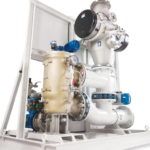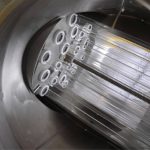Mark Riggio, senior market manager at Hyde Marine, talks in an Interview with HANSA about the challenges of Ballast Water Treatment Systems (BWTS)
What are the main challenges for your company as a manufacturer of BWTS and what do customers ask for[ds_preview]?
Mark Riggio: The main challenge we face in this industry remains the continually shifting landscape of both approvals and implementation guidelines. As different tests and testing methodologies are developed, systems are continually being asked to perform to different standards without a sufficient market to justify the return on investment.
For which types of vessels are your BWTS suitable?
Riggio: We offer systems for all types of ships. With the largest maximum single reactor in the industry, our systems are designed for smaller vessels, but also to give large-size ships the ability to install the UV system they want. We are considering designing an even higher-rated reactor, but it is not known whether the available market for UV systems in this flow range will support the need for this development.
Which technology do your systems use?
Riggio: We use a medium pressure UV disinfection stage matched up with a fine mesh mechanical filter.
Is your system approved by the U.S. Coast Guard?
Riggio: We completed our first round of testing using the MPN methods and have completed preliminary testing to verify our increased dose needed to pass the U.S. Coast Guard’s stain test. We will begin stain testing for U.S. Coast Guard in February of 2017 and we expect to submit our package to the Coast Guard in late 2017.
Why does it take such a long time to get the type approval for the U.S. and worldwide?
Riggio: IMO testing is very straightforward and we are ready to meet the upcoming changes to G8, but the very strict interpretations of the Coast Guard requirements has created delays in obtaining that certification. When we began testing we used a viability method that matched the test methods used to validate UV systems for drinking water around the world. We worked with the Coast Guard for three years getting the MPN method approved and fully completed our testing using this internationally approved method. Unfortunately, despite some initial encouragement, the Coast Guard did not accept our test methods. We now have to retest our equipement to their test standards.
How many systems have you sold and what are your expectations for turnover and order numbers?
Riggio: We continue to be active in securing orders, particularly repeat orders as customers move to continue retrofitting their fleets for the new requirements. More than 460 systems have been ordered with more than 300 systems installed and operational at this time, making us one of the most used ballast water treatment systems. While we don’t report specific turnover numbers, we expect to maintain our leadership position throughout the implementation market.
What are your plans for the future? Are you going to work on other sizes of BWTS or would you rather improve the existing systems?
Riggio: We plan to continue to improve our system based on the experience learned from our installed base. These improvements will need to be tempered by the extensive test requirements needed to make modifications, but we expect to continue to improve our product in a way that continues to support our existing clients.
What is your market share and what are your expectations for 2017?
Riggio: Unfortunately, we do not report specific market share. Our expectation for 2017 is that we will see increased interest with some ship owners beginning to purchase systems for implementation in the 3 and 4 Quarter of 2017.
How do you see the competition in the market? Is there a need for consolidations, take-overs or mergers? Which role does Hyde Marine play in that context?
Riggio: Yes, there is a need for consolidation in the market. Honestly, from a competitive standpoint there are many systems with IMO Type Approvals that we do not see in competition in the market place. These companies may still be viable or they may not. The continued cost of testing and updates to the certification requirements will likely do more to expose the consolidation of the market place. Hyde Marine will remain an aggressive player in the market and will continue to secure a dominant position in both the UV treatment market and the overall ballast water treatment system market.
Interview: Thomas Wägener
Thomas Wägener




















